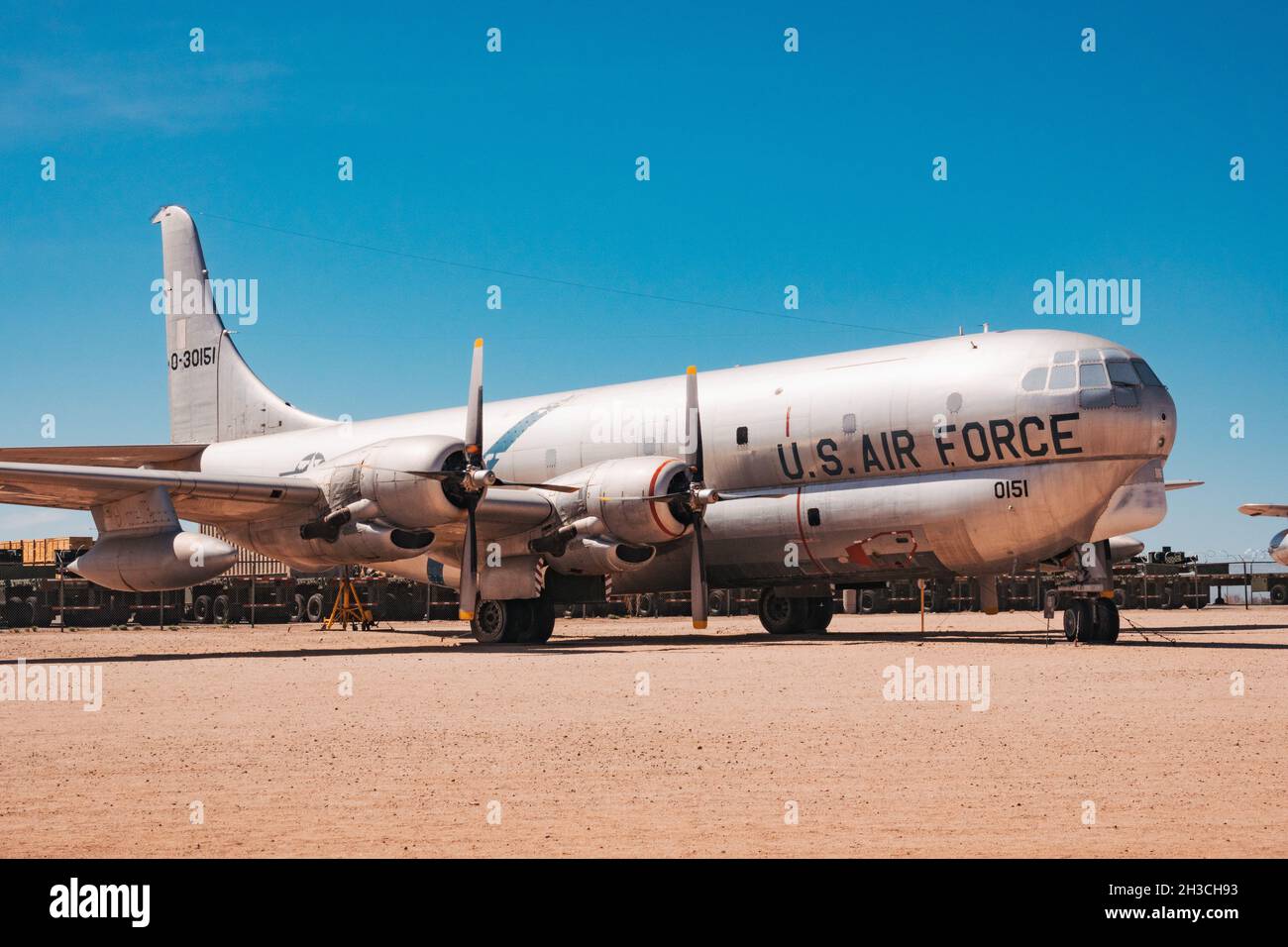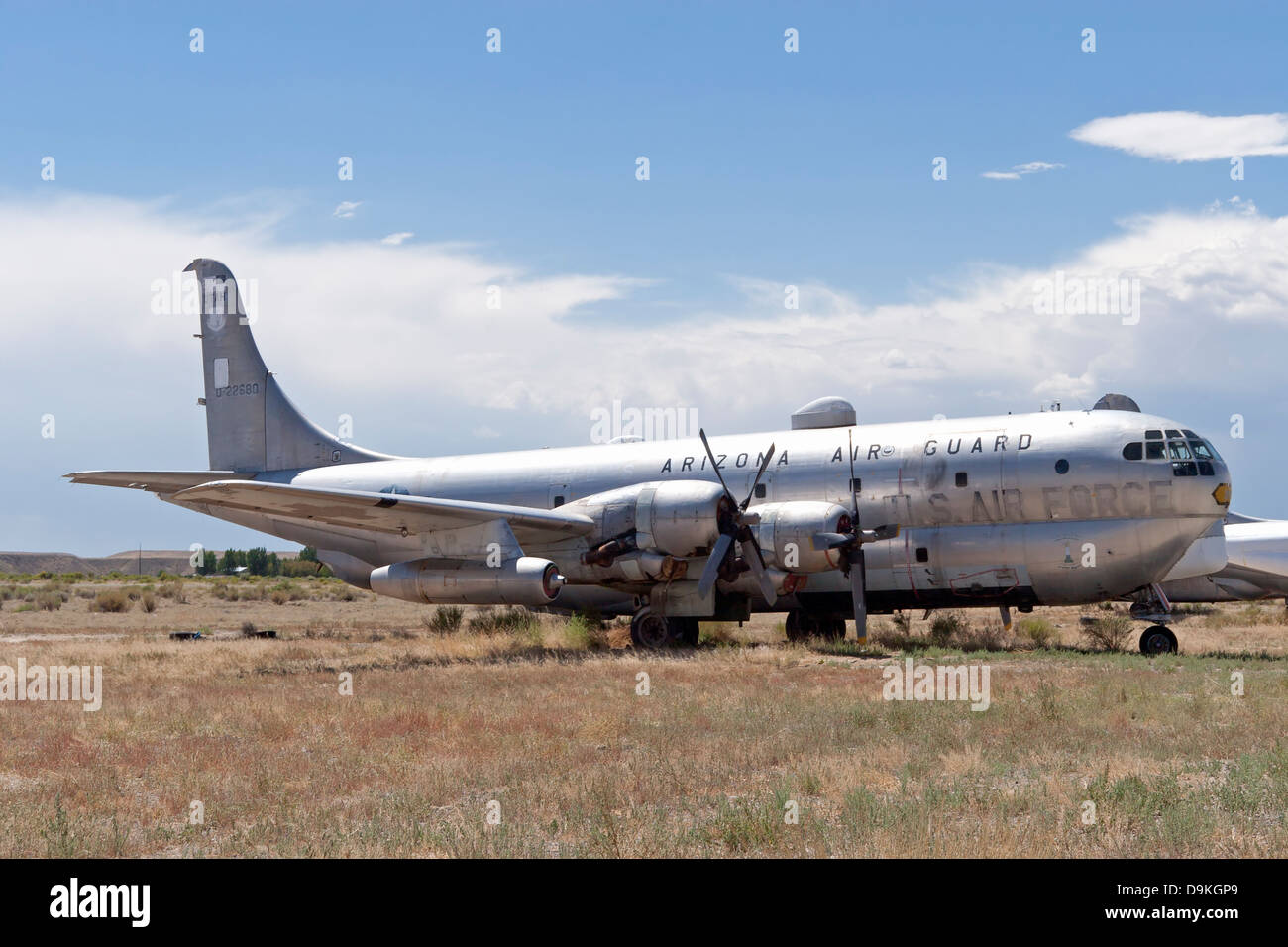C97 Aircraft - C-97s evacuated casualties during the Korean War. C-97s also participated in the Biafran airlift, delivering relief materials to Uli airstrip in Biafra during the Nigerian Civil War. Flying under the cover of darkness and at treetop level to evade radar, at least two C-97s were lost.[1]
The USAF Strategic Air Command operated C-97 Stratofreighters from 1949 through 1978. Early in its service life, it served as an airborne alternative SAC command post. While only 60 C-97 transports were built, 816 were built as KC-97 Stratotankers for inflight refueling.
C97 Aircraft

The civilian derivative of the C-97 was the Boeing 377 Stratocruiser, a very luxurious transoceanic air liner which featured a lower deck lounge and could be fitted with sleeper cabins. The prototype XC-97 was powered by the 2,200 horsepower (1,600 kW) Wright R-3350 engine, the same as used in the B-29.
Interesting Fact
This aircraft and the other pre-production examples were fitted with a shorter fin and rudder than used subsequently. The C-97 had clamshell doors under its tail, so a retractable ramp could be used to drive in cargo.
But unlike the later Lockheed C-130 Hercules, it was not designed as a combat transport which could deliver directly to primitive forward bases using relatively short takeoffs and landings. The rear ramp could not be used in flight for air drops.
The prototype XC-97 was powered by the 2,200 hp (1,640 kW) Wright R-3350 engine, and was fitted with a built-in ramp and a hoist to help in the loading and unloading of supplies and personnel through the large clamshell-type

doors in the belly. On January 9, 1945 the first prototype, piloted by Major Curtin L. Reinhardt, flew from Seattle to Washington, DC in 6 hours 4 minutes, an average speed of 383 mph (616 km/h) with 20,000 pounds (lb) of cargo
Operational History
, which was for its time rather impressive for such a large aircraft. Production models featured the 3,500 hp (2,610 kW) Pratt & Whitney Wasp Major engine, the same engine as the B-50. The Boeing C-97 Stratofreighter was a long range heavy military cargo aircraft based on the B-29 Superfortress bomber.
Design work began in 1942, with the prototype's first flight in 1944, and the production aircraft entering service in 1947. Between 1947 and 1958, 888 C-97s in several variants were built - 816 of them were KC-97 tankers.
C-97s served in the Berlin Airlift, the Korean War, and the Vietnam War. Some aircraft served as flying command posts for the Strategic Air Command, while others were modified for use in Aerospace Rescue and Recovery Squadrons (ARRS).
On 3 November 2000 this aircraft made a one-time flight from Greybull, Wyoming to where it now resides here at the Air Guard Museum. One C-97 aircraft is still flyable, S/N 52/2718, named "Angel of Deliverance" it is operated as a privately owned warbird with the Berlin Airlift Historical Foundation as a flying museum.

Design And Development
The Boeing C-97 Stratofreighter was a long range heavy military cargo aircraft based on the B-29 bomber. Design work began in 1942, with the prototype's first flight being on November 9, 1944, and the first production aircraft entered service in 1947. Between 1947 and 1958, 888 C-97s in several versions were built, 816 being KC-97 tankers.
C-97s served in the Berlin Airlift, the Korean War, and the Vietnam War. Some aircraft served as flying command posts for the Strategic Air Command, while others were modified for use in Aerospace Rescue and Recovery Squadrons (ARRS).
The C-97 had a useful payload of 35,000 lb (16 t) and could carry two normal trucks or light tanks. The C-97 was also the first mass produced air transport to feature cabin pressurization, which made long range missions somewhat more comfortable for the crew and passengers.
On 9 January 1945, the first prototype, piloted by Major Curtin L. Reinhardt, flew from Seattle to Washington, DC in 6 hours 4 minutes, an average speed of 383 miles per hour (616 km/h) with 20,000 pounds (9,100 kg
) of cargo, which was for its time rather impressive for such a large aircraft. Production models featured the 3,500 horsepower (2,600 kW) Pratt & Whitney Wasp Major engine, the same engine as for the B-50. This aircraft entered service in 1955 and ended its USAF mission serving with the Utah Air National Guard.

This aircraft was sold as surplus on November 15, 1983 for $8,500. Following its military career this aircraft was converted to "The Flight 97 Restaurant" in McMinnville Oregon, if you look closely at the tail you can still make out a hamburger that was painted on it.
Also, if you look at the upper fuselage one can still see where the word RESTAURANT was once painted and then removed. This aircraft was then acquired by Hawkins and Powers of Greybull, Wyoming where it sat for many years until the Minnesota Air Guard Museum received it in a one for one trade with a C-123 aircraft the museum owned.
The Israelis turned to Stratocruisers and KC-97s when they could not buy the highly regarded C-130.[citation needed] The Israelis adapted Boeing 377 Stratocruiser airliners into transports, including many using C-97 tail sections including the loading ramp.[citation needed]
needed] Others were adapted with swiveling tails and refueling pods. [citation needed] One Israeli C-97 was downed by an Egyptian SA-2 Guideline missile on 17 September 1971, while flying as an electronic counter-measures platform some 12 miles from the
Suez Canal.[2][3] All C-97 and KC-97 aircraft were retired by 1978. A civilian airliner version of this aircraft was known as the Boeing 377 Stratocruiser with some of these aircraft having been modified to "Supper Guppies" used to carry oversized cargo loads.

This aircraft was the first mass produced air transport to feature cabin pressurization. The Boeing C-97 Stratofreighter was developed towards the end of World War II by fitting an enlarged upper fuselage onto a lower fuselage and wings which were essentially the same as the B-50 Superfortress with the tail, wing, and engine layout being nearly identical
. It was built before the death of Boeing president, Philip G. Johnson. C-97s evacuated casualties during the Korean War. C-97s also participated in the airlift of relief materials to Uli airstrip (Biafra) during the Nigerian Civil War.
Flying under the cover of darkness and at tree-level to evade radar, at least two C-97s were lost.[1] The USAF Strategic Air Command operated C-97 Stratofreighters from 1949 through 1978. Early in its service life, it served as an airborne alternative SAC command post.
While only 60 C-97 transports were built, 812 were built as the KC-97 Stratotanker variant for inflight refueling. The civilian derivative of the C-97 was the Boeing 377 Stratocruiser, a very luxurious transoceanic air liner which featured a lower deck lounge and could be fitted with sleeper cabins.
The C-97 had a useful payload of 35,000 pounds (16,000 kg) and could carry two normal trucks, towed artillery, or light tracked vehicles such as the M56 Scorpion. The C-97 was also the first mass-produced air transport to feature cabin pressurization, which made long range missions somewhat more comfortable for its crew and passengers.

The C-97 Stratofreighter is a long range heavy military cargo aircraft based on the B-29 bomber. The prototype first flight was in 1944. 888 C-97s were built, 816 of them were built as KC-97 tankers (aerial refuelers), the KC-97L aircraft had two additional J47 jet engines mounted on under wing pylons.
The museum aircraft was built as a KC-97L however all the in-flight refueling equipment has been removed to depict a C-97 aircraft. C-97 aircraft served in the Berlin Airlift and in the Korean and Vietnam wars.
One YC-97A was used in the Berlin Airlift during April 1949 operating for the 1st Strategic Support Squadron. It suffered a landing gear accident and by the time it was repaired, the Soviet Blockade was lifted.
The C-97 Stratofreighter was developed towards the end of World War II by fitting an enlarged upper fuselage onto a lower fuselage and wings which were essentially the same as those of the B-50 Superfortress with the tail, wing, and engine layout being nearly
identical. It was built before the death of the president of Boeing, Philip G. Johnson. It can be easily distinguished from the 377 Stratocruiser by the "beak" radome beneath the nose and by the flying boom and jet engines on later tanker models.
c 97 airplane, c 97 stratocruiser, c 97 stratofreighter, boeing c 97, boeing kc 97 stratofreighter, what is c 97, boeing c 97 stratofreighter manual, 73h aircraft alaska airlines